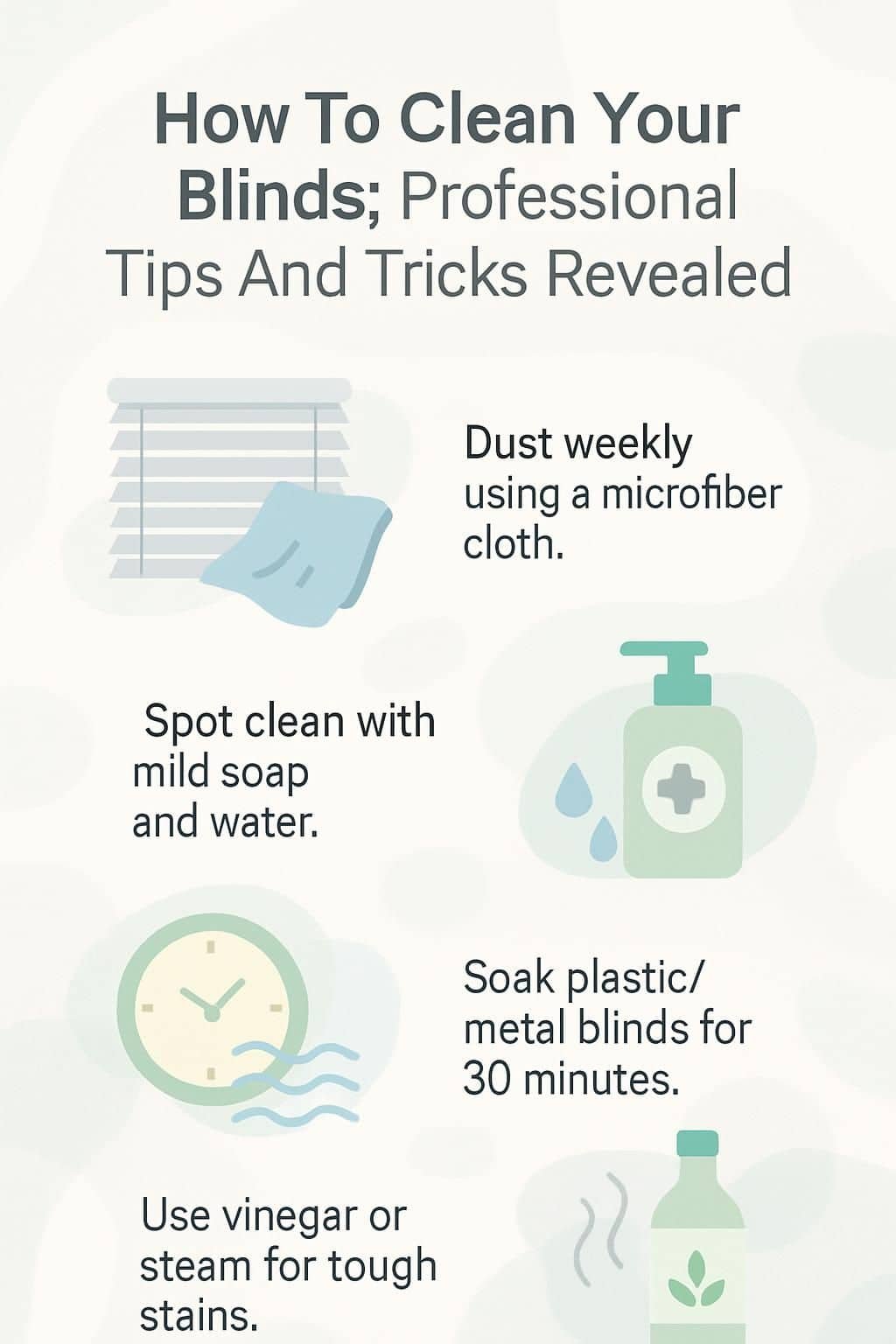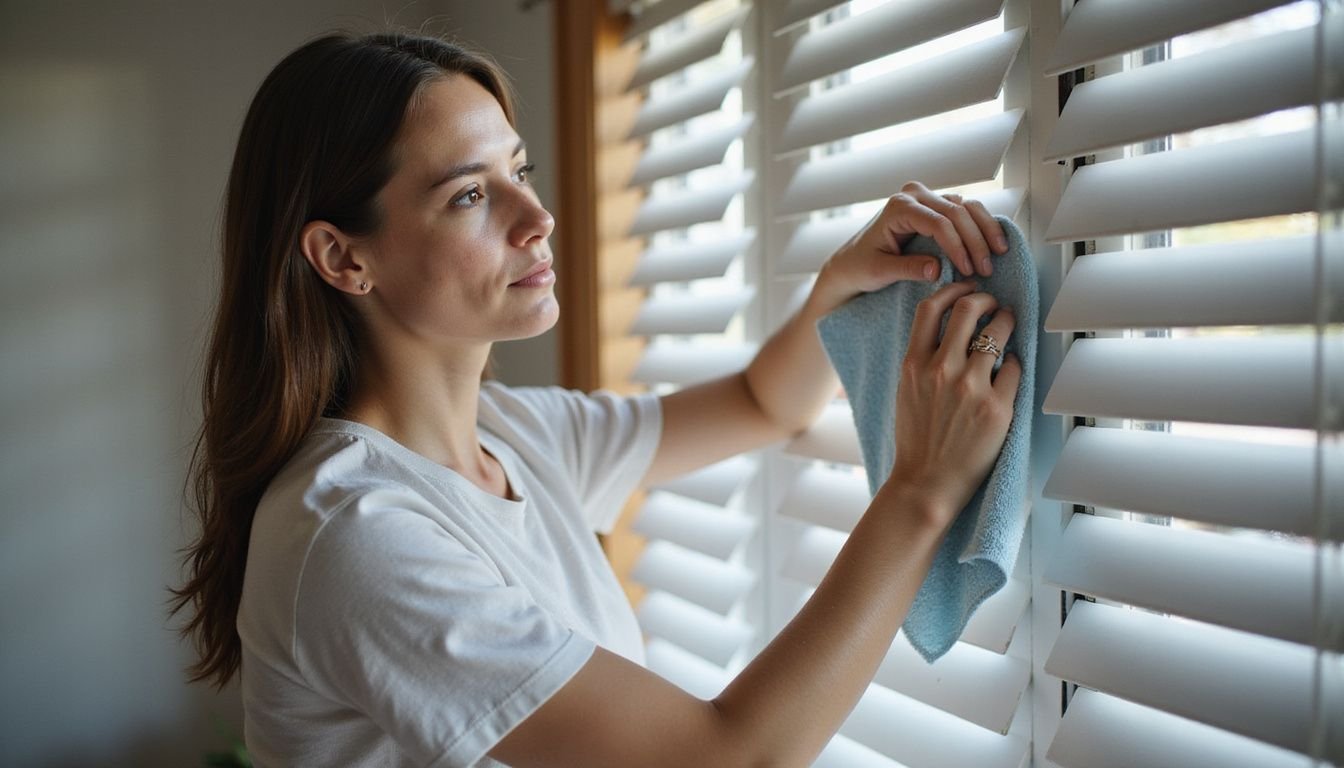Dusty blinds make any room look messy. Many homeowners feel frustrated when cleaning window blinds, especially with so many types like wooden blinds, metal blinds, and vertical blinds.
Smudges seem to appear fast, and dust can linger even after a quick wipe.
Many people do not know that using the right cleaning tools makes a big difference. A simple microfiber cloth or vacuuming with the correct brush attachment cleans better than old rags or paper towels.
This guide on How To Cleaning Your Blinds shares expert tips for each type of blind and reveals what really works. Discover easy steps that save time and keep your window coverings spotless.
Read further to keep your household chores easier than ever before!
Key Takeaways
- Use a microfiber cloth or vacuum with a brush attachment for regular dusting. This method removes most dust from all types of blinds and keeps them looking fresh.
- For spot cleaning, use a damp cloth with mild dish soap. Always test in an invisible area first, especially on wood or fabric blinds, to prevent damage.
- Deep clean plastic and metal blinds by soaking in warm soapy water for 30 minutes. Avoid soaking wooden blinds to prevent warping.
- Vinegar solutions and steam cleaners can remove tough stains without chemicals. These options are safe for families and help lift grime from many blind materials.
- Set up a weekly dusting schedule and use protective coatings if possible. Regular care stops heavy buildup and extends the life of your window blinds.

Basic Steps for Cleaning Blinds

Cleaning blinds can feel like a chore, but it doesn’t have to be difficult. Start with a microfiber cloth or duster to remove dust from each slat. Then, use a vacuum cleaner with a brush attachment for any stubborn particles that remain.
For spots and stains, gently wipe them down using a damp cloth.
Dusting with a microfiber cloth or duster
Microfiber cloths pick up dust on window blinds fast and keep it from flying into the air. Users simply run the microfiber cloth or a feather duster across each slat, working from top to bottom.
This lifts dirt from plastic blinds, metal blinds, wooden blinds, and vertical blinds with little effort.
A dry duster works well for light dusting in household management routines. For extra dirty or sticky areas, many homeowners switch to slightly dampened microfiber cloths. Keeping these cleaning tools handy helps busy parents maintain clean window coverings between deeper cleanings.
Regular use prevents buildup that can make cleaning window blinds harder later on.
Vacuuming with a brush attachment
After using a microfiber cloth or duster to clear away loose dirt from window blinds, some dust and allergens may still linger on plastic blinds, metal blinds, or fabric blinds. Vacuuming with a brush attachment can grab those stubborn particles quickly.
Attach the soft-bristle tool to your vacuum cleaner; this prevents scratches on wooden blinds and helps remove fine dust from vertical blinds.
Move the brush along each slat of the venetian blinds, making sure to reach both sides for thorough cleaning. Use slow strokes so the suction pulls in more debris rather than scattering it into the air.
Parents will find this method safe for children’s rooms since vacuums do not release chemicals or leave moisture behind. For best results, set up a regular cleaning schedule every month to keep dusty blinds looking fresh throughout your home’s inventory of window coverings.
Spot cleaning with a damp cloth
After vacuuming with a brush attachment, some stains and sticky spots may remain on window blinds. Use a microfiber cloth dampened with warm water and a drop of liquid dish soap for safe spot cleaning.
Gently rub the affected area on plastic blinds or metal blinds until the stain lifts. This approach helps avoid spreading dirt to clean parts.
For tougher marks, repeat the process using fresh soapy water each time. Always test any cleaning product in an inconspicuous place first to prevent damage, especially when working with wooden blinds or fabric blinds.
Avoid soaking slats completely to keep moisture from warping or staining them. Parents can use this method as an easy way to keep dusty blinds looking fresh between deeper cleans.
How to Deep Clean Different Types of Blinds
Cleaning different types of blinds requires specific approaches. Wooden blinds need gentle care, while metal or plastic blinds can handle more robust cleaning solutions.
Cleaning wooden blinds
Wooden blinds require special care to keep them looking their best. Start by dusting them with a microfiber cloth or duster. This removes loose dust and dirt without scratching the surface.
For deeper cleaning, use a damp cloth soaked in warm water mixed with mild dishwashing liquid. Wipe each slat thoroughly to remove grime.
Avoid soaking wooden blinds directly in water as this can warp the wood. To protect against dust buildup, consider applying a protective coating specifically designed for wood surfaces.
After cleaning, turn your attention to other types of blinds for a complete window refreshment.
Cleaning aluminum or metal blinds
Switching to aluminum or metal blinds requires a different approach. These materials are easy to clean and maintain, but they do need attention to keep them looking sharp.
Start by dusting the metal blinds using a microfiber cloth or duster. This will remove loose dirt and dust. For deeper cleaning, vacuum with a brush attachment; this method effectively captures particles without scratching the surface.
If stains appear, use a damp cloth with warm water or soapy water for spot cleaning. Avoid abrasive cleaners as they can damage the finish of your aluminum or metal blinds. Regular upkeep ensures these window coverings remain in great shape for years.
Cleaning fabric and vertical blinds
Cleaning fabric and vertical blinds requires a few straightforward steps. Use a microfiber cloth to wipe down the surfaces. This removes dust without spreading it around. For tougher stains, spot clean with a damp cloth.
Lightly dampen the cloth and gently rub the stained area.
Vacuuming can help keep vertical blinds fresh too. Attach a brush nozzle to your vacuum cleaner for effective cleaning. For fabric blinds, consider using dryer sheets after cleaning; they can repel dust and lint.
Regular maintenance ensures that fabric and vertical blinds stay looking their best while reducing allergens in the home.
Advanced Cleaning Methods
Cleaning blinds can be a challenge, but advanced methods offer effective solutions. One useful approach involves using a vinegar solution for its natural cleaning properties. For tougher stains, soaking blinds in a bathtub filled with warm soapy water can work wonders.
Steam cleaning provides another option to tackle stubborn grime and dirt that routine methods might miss. Each of these techniques helps maintain the freshness of your window coverings and extends their lifespan.
Explore more tips to enhance your blind-cleaning routine!
Using a vinegar solution
A vinegar solution provides an effective way to clean dusty blinds. Mix equal parts of warm water and white vinegar in a bowl or spray bottle. Spray the mixture onto a microfiber cloth, then wipe down the blinds thoroughly.
The acidity of the vinegar helps break down dirt and grime without harsh chemicals.
For stubborn stains, let the solution sit for a few minutes before wiping it off. This method works well on various types of window blinds, including plastic, aluminum, and fabric shades.
After cleaning with the vinegar solution, follow up by drying with a fresh cloth to prevent streaks and spots from forming.
Soaking blinds in a bathtub
Soaking blinds in a bathtub provides an effective way to remove stubborn dirt. Fill the tub with warm water and add some dishwashing liquid or a gentle soap. Carefully submerge each blind into the soapy water, allowing them to soak for about 30 minutes.
This method works well for plastic blinds and fabric blinds.
After soaking, gently scrub away grime using a microfiber cloth or sponge. Rinse each blind thoroughly under clean water before placing them back in their original location. Avoid harsh chemicals that could damage the material.
This deep cleaning technique will refresh dusty blinds and keep them looking new longer.
Steam cleaning for tough stains
Steam cleaning offers a strong solution for removing tough stains from blinds. It effectively penetrates fabric and surfaces, lifting dirt without harsh chemicals. Homeowners can use steam cleaners designed specifically for various materials like fabric or plastic blinds.
Start by setting the steam cleaner to the appropriate setting for the type of blinds being cleaned. For stubborn stains on vertical or wooden blinds, keep the nozzle close to the surface for better results.
Allow the steam to work before wiping away debris with a microfiber cloth. Using this method ensures a thorough clean and helps maintain the appearance of window blinds over time.
Tips for Maintaining Clean Blinds
Maintaining clean blinds requires a regular dusting routine. House owners can use a microfiber cloth or duster every week to keep dusty blinds at bay.
Regular dusting schedule
House owners should set a regular dusting schedule for their window blinds. Dust can accumulate quickly on all types, including wooden blinds and vertical blinds. A weekly routine helps keep them clean and fresh.
Using a microfiber cloth or duster makes the job easier. This tool captures dust effectively without spreading it around. For metal and plastic blinds, a damp cloth works well too.
Keeping up with this simple task prevents dusty blinds from becoming an eyesore in any room.
Avoiding harsh chemicals
Many homeowners worry about using harsh chemicals to clean their blinds. These strong substances can harm both the blinds and the environment. Instead, they should consider natural alternatives like soapy water or vinegar solutions.
Using mild dishwashing liquids mixed with warm water effectively cleans various types of window blinds without causing damage. This approach keeps dusty blinds looking fresh while being safe for families and pets.
Vertical or fabric blinds benefit from this gentle method, as it avoids potential wear from abrasive cleaners. Using dryer sheets also helps repel dust and reduce static cling between cleanings, keeping home maintenance simple and effective.
Using protective coatings to repel dust
Protective coatings can help repel dust from window blinds. They create a smooth surface that makes it harder for dust to settle. These coatings work well on various types of blinds, including aluminum and plastic.
House owners can apply them easily and maintain their blinds longer.
Using protective sprays or treatments keeps dusty blinds looking clean. Regular application helps reduce the buildup of dirt and grime, making cleaning easier in the long run. Next, deep cleaning different types of blinds will further enhance their appearance and lifespan.
Conclusion
Cleaning window blinds does not have to be a chore. With simple steps, anyone can keep their blinds looking fresh and tidy. Regular maintenance prevents dust buildup and keeps them in great shape.
Whether using a microfiber cloth or soaking them for deep cleaning, these tips make the job easier. Armed with professional advice, homeowners can enjoy spotless blinds all year round.
FAQs
1. What is the best way to clean dusty window blinds without damaging them?
Use a microfiber cloth for gentle dusting on all types of window blinds. For plastic or metal blinds, wipe each slat with a damp cloth dipped in warm water mixed with mild dishwasher powder.
2. Can I use soapy water on wooden and fabric blinds?
Do not use soapy water on wooden shades; it can warp the material. Clean wooden versions with a dry microfiber cloth only. Fabric styles should be vacuumed or, if needed, dry-cleaned by professionals.
3. How do you remove stubborn stains from vertical and plastic models?
For tough spots on vertical or plastic designs, apply a small amount of soapy water using a soft sponge. Rinse gently and let them air dry before closing.
4. Are there any tools that make cleaning easier for homemaking tasks like this?
Dryer sheets work well to repel dust after wiping down your coverings. Specialized cleaning tools designed for cleaning window treatments can also speed up the process and reach tight spaces between slats.
5. Is it safe to wash metal units in the shower?
You may rinse aluminum varieties in the shower using warm water if they are very dirty; avoid soaking hardware parts to prevent rusting or damage to moving pieces during routine maintenance sessions.


